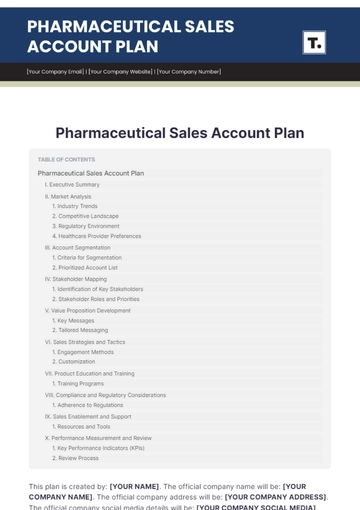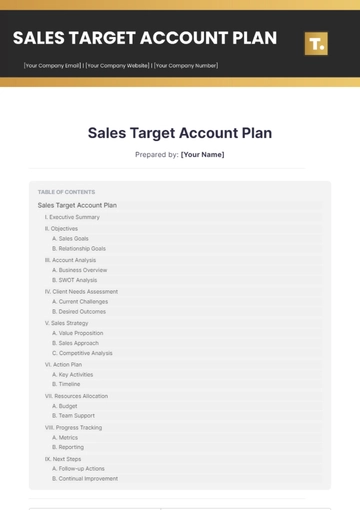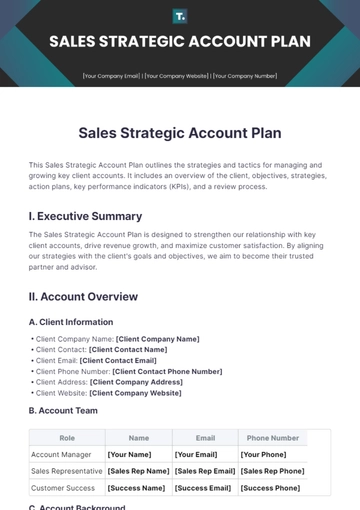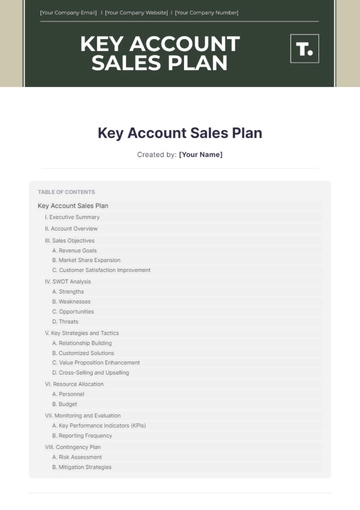Free Monthly Sales Plan

Introduction
The purpose of this Monthly Sales Plan is to provide a structured approach for [Your Company Name]'s sales activities for the coming month. This document will serve as a roadmap for the sales, marketing, and account management teams to align their efforts in achieving company objectives. The plan outlines target goals, identifies key strategies, and specifies an action plan to ensure optimal performance. It is intended for internal circulation and may be updated as business needs evolve.
Executive Summary
The aim is to provide a comprehensive overview that encapsulates the company's sales objectives, action plans, and key performance indicators for the coming month. The document is tailored to focus on driving growth through customer acquisition, augmenting monthly revenue, retaining current customers, and the strategic sale of Products X and Y.
The plan further incorporates a budget allocation across various sales and marketing channels. Executing this plan effectively will not only achieve but may exceed the set targets, thereby contributing significantly to the company's overall business objectives.
Objectives
The objectives for this Monthly Sales Plan are designed to align with [Your Company Name]'s overarching business goals and to serve as key performance metrics. Below is a detailed breakdown of each objective:
Objective | Target |
|---|---|
New Customer Acquisition | Acquire 100 new customers |
Monthly Revenue | Generate $50,000 in revenue |
Customer Retention Rate | Maintain an 85% retention rate |
Product X Sales | Sell 300 units of Product X |
Product Y Sales | Sell 200 units of Product Y |
New Customer Acquisition: Growth is a pivotal focus for this month, and customer acquisition serves as the cornerstone for achieving this. The figure is set at a challenging yet attainable level to push the sales team to engage in proactive outreach efforts.
Monthly Revenue: This revenue target encompasses all revenue streams, including but not limited to sales of Products X and Y, subscription fees, and upsell opportunities. Achieving this target would mark a 10% increase over last month's revenue, indicating positive growth.
Customer Retention Rate: Retaining existing customers is generally more cost-effective than acquiring new ones. Achieving a high retention rate indicates customer satisfaction and could result in word-of-mouth referrals.
Product X Sales: Product X has been identified as a key growth driver for the company. Increasing its sales volume is integral for not just revenue, but also for enhancing market share in its respective category.
Product Y Sales: Although Product Y serves a niche market, it enjoys higher profit margins. Thus, selling 200 units will significantly contribute to achieving the monthly revenue target.
By comprehensively defining each objective and providing a rationale, we establish a clear direction for the sales and marketing teams. These objectives are quantifiable, measurable, and time-bound, thereby adhering to SMART criteria (specific, measurable, achievable, relevant, time-bound).
Strategies
To accomplish the objectives outlined in the previous section, it is imperative to deploy a set of well-thought-out strategies. These strategies are designed to optimize resources, improve efficiency, and maximize outcomes. Here is an enhanced look at each strategic component:
Digital Marketing: Digital marketing offers a highly scalable and customizable approach to reaching a broad or targeted audience. By allocating a substantial budget to digital channels, we aim to drive online engagement and consequently increase sales.
Social Media Advertising: Employ targeted ad campaigns on platforms such as Facebook and LinkedIn to reach potential customers.
Search Engine Marketing: Use Google Ads to appear in keyword-based searches relevant to our products and services.
Cold Calling: Cold calling remains an effective strategy for direct engagement. A targeted approach, aided by segmentation and custom scripting, will improve our conversion rates from these calls.
Contact List Segmentation: Categorize prospective clients into high-value and standard-value groups.
Script Development: Create scripts that are tailored to address the specific needs and pain points of potential customers.
Client Meetings: Client meetings provide the opportunity for face-to-face engagement, enabling us to form stronger relationships with key accounts. A smaller budget is allocated here due to the focused nature of this strategy but the expected ROI is high.
Pre-meeting Research: Conduct in-depth research on potential clients to understand their business needs.
Presentation: Develop a customized sales presentation focusing on how our products or services can solve the client's problems.
Strategy | Budget Allocation |
|---|---|
Digital Marketing | $10,000 |
Cold Calling | $1,000 |
Client Meetings | $500 |
By these enhanced strategies, [Your Company Name] aims to provide a multifaceted approach to achieving its sales objectives. Each strategy has been selected for its proven efficacy and will be executed with meticulous planning and monitoring. The balanced budget allocation for each strategy ensures that we are investing in channels that promise the best return on investment.
Action Plan
To operationalize the strategies outlined, it is essential to have a detailed action plan in place. This plan serves as a week-by-week guide for all departments involved in sales and marketing, delineating specific actions, responsible parties, and budget allocations. The action plan is designed to be both dynamic and adaptable to respond to real-time data and results.
Week 1: Launch of Digital Marketing Initiative
Action | Responsible |
|---|---|
Launch new Google Ads campaign | Marketing Team |
Begin Social Media Ads | Marketing Team |
The first week is crucial for setting the tone for the entire month. The primary focus will be on launching digital marketing campaigns to generate initial traction.
Week 2: Initiate Cold Calling and Outreach Efforts
Action | Responsible |
|---|---|
Initiate cold calling | Sales Team |
Send targeted email campaigns | Marketing Team |
Building on the leads generated in the first week, the Sales Team will engage in direct outreach to secure appointments, while the Marketing Team supports this with targeted email campaigns.
Week 3: Client Engagement and Relationship Building
Action | Responsible |
|---|---|
Schedule client meetings | Account Managers |
Follow-up on cold calls and emails | Sales Team |
Week 3 is devoted to deepening engagement, particularly through client meetings arranged by Account Managers and follow-ups conducted by the Sales Team.
Week 4: Evaluation and Strategy Adjustment
Action | Responsible |
|---|---|
Evaluate KPIs | Analytics Team |
Adjust strategy based on analytics | Management |
The final week of the month will focus on evaluating performance metrics and making necessary adjustments for future plans. The Analytics Team will prepare a comprehensive report to inform these decisions.
Expected Outcomes:
Action | Expected Outcome |
|---|---|
Launch new Google Ads campaign | Generate 200 leads |
Begin Social Media Ads | Achieve 50 conversions |
Initiate cold calling | Secure 10 appointments |
Send targeted email campaigns | Achieve 15% open rate |
Schedule client meetings | Close 3 high-value deals |
Follow-up on cold calls and emails | Achieve 5 conversions |
Evaluate KPIs | Comprehensive report |
Adjust strategy based on analytics | Strategy pivot plan |
Budget Allocation Overview:
Action | Budget |
|---|---|
Launch new Google Ads campaign | $2,500 |
Begin Social Media Ads | $2,000 |
Initiate cold calling | $1,000 |
Send targeted email campaigns | $500 |
Schedule client meetings | $500 |
Follow-up on cold calls and emails | $300 |
Evaluate KPIs | - |
Adjust strategy based on analytics | - |
TOTAL: | $6,800 |
This action plan is structured to ensure that every week is focused on executing particular strategies while maintaining a level of flexibility. This level of granularity allows [Your Company Name] to track progress closely and make informed decisions for future planning.
Key Performance Indicators
Key Performance Indicators (KPIs) serve as quantifiable metrics that provide valuable insights into the effectiveness of sales and marketing strategies. A detailed examination of each KPI helps in not only measuring success but also in identifying areas of improvement. This section elaborates on the selected KPIs that will be closely monitored throughout the month.
Cost Per Acquisition (CPA): CPA serves as a litmus test for the efficiency of customer acquisition activities. A low CPA is desirable as it indicates that fewer resources are being consumed to gain new customers. Conversely, a high CPA can signify inefficiencies and necessitate a review of marketing channels and methods.
Formula: CPA = Total Expenditure on Sales and Marketing Activities / Total Number of New Customers Acquired
Customer Lifetime Value (CLV): The CLV metric allows for strategic decision-making in resource allocation, enabling the company to invest in retaining high-value customers. It offers a long-term view of customer value, which can be balanced against CPA for more sustainable growth.
Formula: CLV = (Average Purchase Value - Cost of Goods Sold) x Average Number of Repeat Sales
Monthly Recurring Revenue (MRR): MRR is a crucial indicator for businesses with subscription models. It gives insights into revenue stability and can be a basis for projections in business growth and sustainability.
Formula: MRR = Number of Subscribers x Monthly Subscription Fee
Conversion Rate: Monitoring the conversion rate offers insights into the quality of leads and the effectiveness of the sales funnel. An optimized conversion rate reduces wastage of leads and resources.
Formula: Conversion Rate = (Number of Conversions / Total Number of Leads) x 100
Churn Rate: A lower churn rate is indicative of customer satisfaction, which in turn can lead to a higher customer retention rate and increased CLV. Monitoring and reducing churn rate can have a significant impact on profitability.
Formula: Churn Rate = (Number of Customers Lost / Number of Customers at Start of Period) x 100
By deeply analyzing these fKPIs, [Your Company Name] commits to a comprehensive, data-driven evaluation of its sales and marketing endeavors. This in-depth approach lays a strong foundation for timely reviews, strategic recalibrations, and continuous performance improvement.
Conclusion
This Monthly Sales Plan sets forth the framework for achieving the sales objectives for the month. All teams are encouraged to collaborate effectively to meet or exceed the targets. Regular monitoring and adjustment of strategies will be essential for the successful implementation of this plan.
- 100% Customizable, free editor
- Access 1 Million+ Templates, photo’s & graphics
- Download or share as a template
- Click and replace photos, graphics, text, backgrounds
- Resize, crop, AI write & more
- Access advanced editor
Take control of your monthly sales targets with this Monthly Sales Plan Template—a strategic resource for your business aiming to maximize its revenue potential. This customizable and editable template, accessible via Template.net's AI Editor Tool, allows you to craft detailed sales plans aligned with your objectives. Drive growth with Template.net!
You may also like
- Finance Plan
- Construction Plan
- Sales Plan
- Development Plan
- Career Plan
- Budget Plan
- HR Plan
- Education Plan
- Transition Plan
- Work Plan
- Training Plan
- Communication Plan
- Operation Plan
- Health And Safety Plan
- Strategy Plan
- Professional Development Plan
- Advertising Plan
- Risk Management Plan
- Restaurant Plan
- School Plan
- Nursing Home Patient Care Plan
- Nursing Care Plan
- Plan Event
- Startup Plan
- Social Media Plan
- Staffing Plan
- Annual Plan
- Content Plan
- Payment Plan
- Implementation Plan
- Hotel Plan
- Workout Plan
- Accounting Plan
- Campaign Plan
- Essay Plan
- 30 60 90 Day Plan
- Research Plan
- Recruitment Plan
- 90 Day Plan
- Quarterly Plan
- Emergency Plan
- 5 Year Plan
- Gym Plan
- Personal Plan
- IT and Software Plan
- Treatment Plan
- Real Estate Plan
- Law Firm Plan
- Healthcare Plan
- Improvement Plan
- Media Plan
- 5 Year Business Plan
- Learning Plan
- Marketing Campaign Plan
- Travel Agency Plan
- Cleaning Services Plan
- Interior Design Plan
- Performance Plan
- PR Plan
- Birth Plan
- Life Plan
- SEO Plan
- Disaster Recovery Plan
- Continuity Plan
- Launch Plan
- Legal Plan
- Behavior Plan
- Performance Improvement Plan
- Salon Plan
- Security Plan
- Security Management Plan
- Employee Development Plan
- Quality Plan
- Service Improvement Plan
- Growth Plan
- Incident Response Plan
- Basketball Plan
- Emergency Action Plan
- Product Launch Plan
- Spa Plan
- Employee Training Plan
- Data Analysis Plan
- Employee Action Plan
- Territory Plan
- Audit Plan
- Classroom Plan
- Activity Plan
- Parenting Plan
- Care Plan
- Project Execution Plan
- Exercise Plan
- Internship Plan
- Software Development Plan
- Continuous Improvement Plan
- Leave Plan
- 90 Day Sales Plan
- Advertising Agency Plan
- Employee Transition Plan
- Smart Action Plan
- Workplace Safety Plan
- Behavior Change Plan
- Contingency Plan
- Continuity of Operations Plan
- Health Plan
- Quality Control Plan
- Self Plan
- Sports Development Plan
- Change Management Plan
- Ecommerce Plan
- Personal Financial Plan
- Process Improvement Plan
- 30-60-90 Day Sales Plan
- Crisis Management Plan
- Engagement Plan
- Execution Plan
- Pandemic Plan
- Quality Assurance Plan
- Service Continuity Plan
- Agile Project Plan
- Fundraising Plan
- Job Transition Plan
- Asset Maintenance Plan
- Maintenance Plan
- Software Test Plan
- Staff Training and Development Plan
- 3 Year Plan
- Brand Activation Plan
- Release Plan
- Resource Plan
- Risk Mitigation Plan
- Teacher Plan
- 30 60 90 Day Plan for New Manager
- Food Safety Plan
- Food Truck Plan
- Hiring Plan
- Quality Management Plan
- Wellness Plan
- Behavior Intervention Plan
- Bonus Plan
- Investment Plan
- Maternity Leave Plan
- Pandemic Response Plan
- Succession Planning
- Coaching Plan
- Configuration Management Plan
- Remote Work Plan
- Self Care Plan
- Teaching Plan
- 100-Day Plan
- HACCP Plan
- Student Plan
- Sustainability Plan
- 30 60 90 Day Plan for Interview
- Access Plan
- Site Specific Safety Plan





























